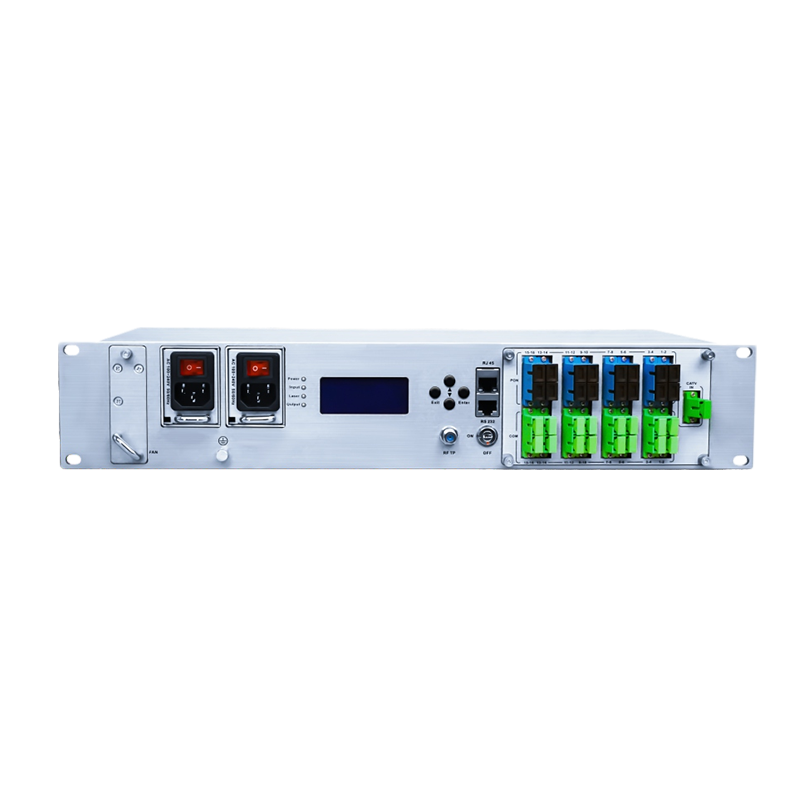1550nm EDFA fiber amplifier: key technology and future development of optical communication network
In modern optical communication systems, in order to overcome the attenuation problem of optical signals in long-distance transmission, the use of optical amplifiers has become the mainstream technology. Among them, 1550nm EDFA (Erbium-Doped Fiber Amplifier) is the most common and widely used one. Since the 1550nm wavelength is in the low-loss window of optical fiber communication, EDFA technology can greatly increase the signal transmission distance and become a key device in optical communication networks.
EDFA is an optical amplifier based on erbium-doped fiber (EDF). Its core working principle is to excite erbium-doped ions through pump lasers to amplify the input optical signals within the 1550nm wavelength range. The specific process is as follows:
Pump excitation: EDFA usually uses a 980nm or 1480nm pump laser to provide energy.
Energy level transition: Pump light excites erbium-doped ions, causing them to transition from the ground state to a high energy level and remain in an excited state.
Stimulated radiation amplification: When the input 1550nm signal light passes through the erbium-doped fiber, the excited erbium-doped ions will emit photons by stimulated radiation, thereby enhancing the intensity of the signal light and achieving optical signal amplification.
This optical amplification mechanism of EDFA does not require the signal to be converted into an electrical signal, so it has the advantages of high gain, low noise, and broadband amplification, and is very suitable for large-capacity optical communication systems.
High gain and high saturated output power
EDFA provides high gain in the 1550nm wavelength range (generally up to 20-40dB), which can effectively compensate for the loss in long-distance optical fiber transmission.
The output power can usually reach +10dBm to +30dBm, which is suitable for a variety of optical network applications.
Low Noise Figure (NF)
Due to the stimulated emission characteristics of erbium-doped ions, EDFA has a low noise figure (typical value is about 4.5-6dB), which helps to maintain the quality of optical signals.
Broadband amplification
The gain bandwidth of 1550nm EDFA Optical Amplifier can usually cover 1530nm-1565nm (C band) or 1570nm-1605nm (L band), which is suitable for WDM (wavelength division multiplexing) system to achieve simultaneous amplification of multi-wavelength signals.
All-optical amplification, no photoelectric conversion required
EDFA can directly amplify optical signals without converting them into electrical signals and remodulating them, reducing system complexity and power consumption and improving transmission efficiency.

High reliability and low maintenance cost
Since EDFA uses optical fiber as the gain medium and has no complex electronic amplification components inside, it has a long life and high stability and is widely used in long-distance optical fiber communication systems.
1. Long-distance optical fiber communication
In optical fiber communication systems, signals will attenuate due to optical fiber loss during transmission. EDFA can be used as a relay amplifier in the fiber trunk line, allowing the signal to be transmitted hundreds or even thousands of kilometers without loss, and is widely used in:
Backbone Network
Metropolitan Area Network (MAN) and Wide Area Network (WAN)
Submarine Cable Communication System
2. DWDM (Dense Wavelength Division Multiplexing) System
DWDM (Dense Wavelength Division Multiplexing) technology allows multiple wavelength signals to be transmitted in the same optical fiber, improving the utilization rate of optical fiber. EDFA can simultaneously amplify multiple wavelength signals in the C band or L band, and is the core device in the DWDM system.
3. CATV (Cable TV) Fiber Transmission
In fiber-to-the-home (FTTH) and cable TV (CATV) networks, 1550nm EDFA is used for signal distribution amplification to support multiple user terminals to receive high-quality video, audio and data signals.
4. LiDAR and Fiber Optic Sensing
EDFA is also used in LiDAR and fiber optic sensing systems to provide powerful optical amplification capabilities for long-distance detection and high-precision measurement.
With the continuous development of optical communication technology, 1550nm EDFA is developing towards higher performance, lower power consumption and more intelligent direction:
More efficient pumping technology
Use higher power 980nm pump laser to improve amplification efficiency and reduce power consumption.
Combined with advanced pump management algorithm, more precise power control can be achieved.
Wideband amplification capability
In the future, EDFA will further expand the gain bandwidth to support larger capacity DWDM systems and improve the throughput of optical fiber communication.
Integration and miniaturization
By combining with optoelectronic integrated chip (PIC), more compact and more integrated EDFA is developed to meet the needs of data centers and next-generation optical networks.
Intelligent management and remote monitoring
Adopt AI and intelligent monitoring system to realize real-time power regulation and fault diagnosis, and improve network operation efficiency.
As the core equipment in optical communication system, 1550nm EDFA fiber amplifier plays an important role in long-distance optical fiber communication, DWDM system, CATV network and optical fiber sensing with its high gain, low noise and broadband amplification characteristics. As the demand for optical communications continues to grow, EDFA technology is also evolving. In the future, it will develop in the direction of greater efficiency, intelligence, and integration, providing strong support for the development of global optical networks.

















